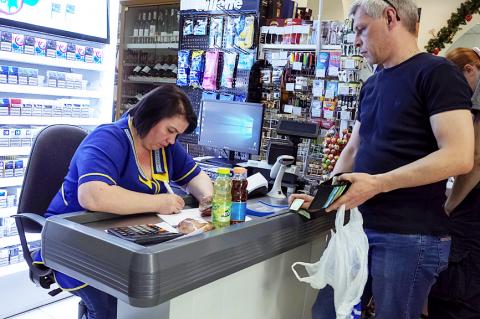Lloyd’s of London has warned that a serious cyberattack could cost the global economy more than US$120 billion — as much as catastrophic natural disasters, such as Hurricanes Katrina and Sandy.
Published two months after a ransomware cyberattack that hobbled National Health Service hospitals and hit nearly 100 countries, a 56-page report from the world’s oldest insurance market says the threat posed by such global attacks has spiraled and poses a huge risk to business and governments over the next decade.
The most likely scenario is a malicious hack that takes down a cloud service provider with estimated losses of US$53 billion, according to Lloyd’s.

Photo: Reuters
This is the average estimate, but because of the uncertainty around calculating cyberlosses it estimates the figure could be as high as US$121 billion or as low as US$15 billion.
At the upper end, the cost would outstrip the damage wreaked by Hurricane Katrina in 2005, estimated at US$108 billion (including US$80 billion of insured losses). Hurricane Sandy in 2012 is estimated to have caused economic losses of US$50 billion to US$70 billion.
“This report gives a real sense of the scale of damage a cyberattack could cause the global economy. Just like some of the worst natural catastrophes, cyberevents can cause a severe impact on businesses and economies, trigger multiple claims and dramatically increase insurers’ claims costs,” Lloyd’s chief executive Inga Beale said.
“Underwriters need to consider cyber cover in this way and ensure that premium calculations keep pace with the cyberthreat reality,” she said.
The second-most likely threat stems from attacks on computer operating systems run by a large number of businesses around the world, which could cause losses of up to US$28.7 billion (the “mass software vulnerability scenario”).
The majority of these losses are not insured, leaving governments and businesses vulnerable if cyberattacks happen. The uninsured gap could be as high as US$45 billion for the cloud services scenario, and US$26 billion for the mass vulnerability scenario.
Trevor Maynard, Lloyd’s head of innovation and co-author of the report with the cybersecurity firm Cyence, said the global cyberattack in May “showed us that these sorts of attacks are absolutely possible.”
Financial services are most at risk, followed by software and technology, hospitality, retail and healthcare. Cyber cover is a relatively new type of insurance that has emerged in the last few years — Lloyds’s accounts for about a quarter of global premiums — and harder to model and understand than natural catastrophe cover.
Where people are involved, risk changes quite rapidly, Maynard said, from cyberattacks to terrorism and political risk. However, climate change remains the biggest challenge in the long run.
“From year to year, risk varies relatively little but climate change in the end will be far larger as a risk,” he said. “It affects the global economic structure, food, water. [It’s like] trying to turn a supertanker around — we can’t start in 30 years when things are going bad, we have to start now.”

Six Taiwanese companies, including contract chipmaker Taiwan Semiconductor Manufacturing Co. (TSMC), made the 2025 Fortune Global 500 list of the world’s largest firms by revenue. In a report published by New York-based Fortune magazine on Tuesday, Hon Hai Precision Industry Co. (better known as Foxconn) ranked highest among Taiwanese firms, placing 28th with revenue of US$213.69 billion. Up 60 spots from last year, TSMC rose 60 places to reach No. 126 with US$90.16 billion in revenue, followed by Quanta Computer Inc. at 348th, Pegatron Corp. at 461st, CPC Corp., Taiwan at 494th and Wistron Corp. at 496th. According to Fortune, the world’s

NEW PRODUCTS: MediaTek plans to roll out new products this quarter, including a flagship mobile phone chip and a GB10 chip that it is codeveloping with Nvidia Corp MediaTek Inc (聯發科) yesterday projected that revenue this quarter would dip by 7 to 13 percent to between NT$130.1 billion and NT$140 billion (US$4.38 billion and US$4.71 billion), compared with NT$150.37 billion last quarter, which it attributed to subdued front-loading demand and unfavorable foreign exchange rates. The Hsinchu-based chip designer said that the forecast factored in the negative effects of an estimated 6 percent appreciation of the New Taiwan dollar against the greenback. “As some demand has been pulled into the first half of the year and resulted in a different quarterly pattern, we expect the third quarter revenue to decline sequentially,”

WEAKER ACTIVITY: The sharpest deterioration was seen in the electronics and optical components sector, with the production index falling 13.2 points to 44.5 Taiwan’s manufacturing sector last month contracted for a second consecutive month, with the purchasing managers’ index (PMI) slipping to 48, reflecting ongoing caution over trade uncertainties, the Chung-Hua Institution for Economic Research (CIER, 中華經濟研究院) said yesterday. The decline reflects growing caution among companies amid uncertainty surrounding US tariffs, semiconductor duties and automotive import levies, and it is also likely linked to fading front-loading activity, CIER president Lien Hsien-ming (連賢明) said. “Some clients have started shifting orders to Southeast Asian countries where tariff regimes are already clear,” Lien told a news conference. Firms across the supply chain are also lowering stock levels to mitigate

DIVERSIFYING: Taiwanese investors are reassessing their preference for US dollar assets and moving toward Europe amid a global shift away from the greenback Taiwanese investors are reassessing their long-held preference for US-dollar assets, shifting their bets to Europe in the latest move by global investors away from the greenback. Taiwanese funds holding European assets have seen an influx of investments recently, pushing their combined value to NT$13.7 billion (US$461 million) as of the end of last month, the highest since 2019, according to data compiled by Bloomberg. Over the first half of this year, Taiwanese investors have also poured NT$14.1 billion into Europe-focused funds based overseas, bringing total assets up to NT$134.8 billion, according to data from the Securities Investment Trust and Consulting Association (SITCA),